#rongqiu
Explore tagged Tumblr posts
Text
Fox lady bday art 🦊

I have the idea of art nouveau sujue in the back of my head for a while now, its not quite the same but this is it for now xD
Also yes i love mixing art nouveau and hanfu (surprisingly this is like second time i draw someone wearing hanfu in this style haha)
Anyway textless version cause im not sure how to feel towards the typography...

#dislyte#dislyte fanart#digital art#art#dislyte su jue#art nouveau#artists on tumblr#su daji#nine tailed fox#chinese hanfu#qixiong ruqun#rongqiu
609 notes
·
View notes
Note
Hi my friend wanted to ask about Chinese Opera and the red pom poms on their hats and their significance. I asked my mom and she said they were for decoration so I just wanted clarification
Hi! Thanks for the question, and sorry for taking ages to reply!
The pom poms you see on 盔头/kuitou (Chinese opera headdresses) are called 绒球/rongqiu (lit. "velvet ball"). They are often red, but can also be other colors, and vary in size. Rongqiu are decorative and serve to distinguish the many different types of kuitou from one another. Each type of kuitou is distinct in the number, size, and color of rongqiu that it's decorated with (of course, not all kuitou have rongqiu).
Below - a few different types of Beijing opera kuitou decorated with rongqiu (x):
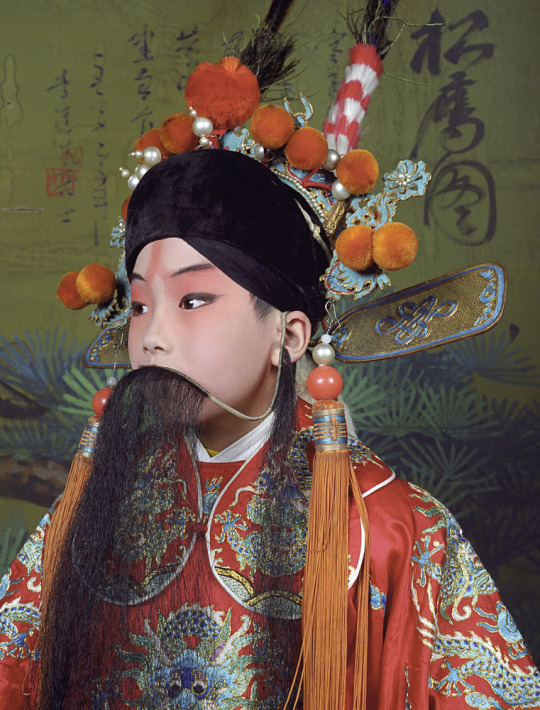
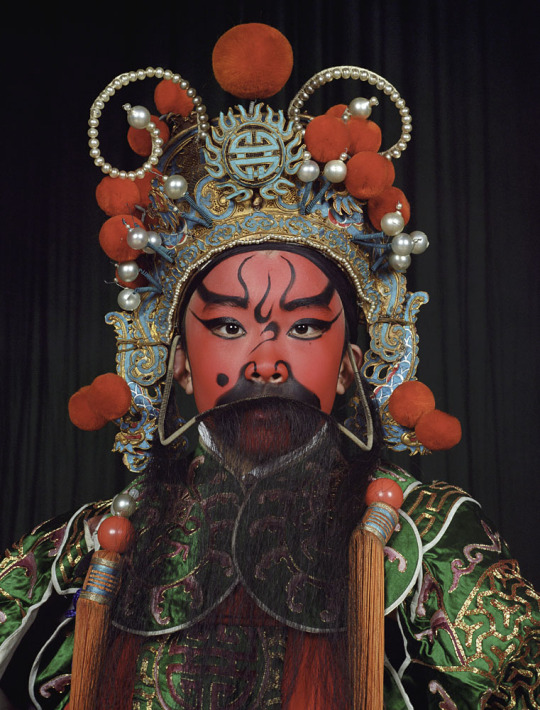

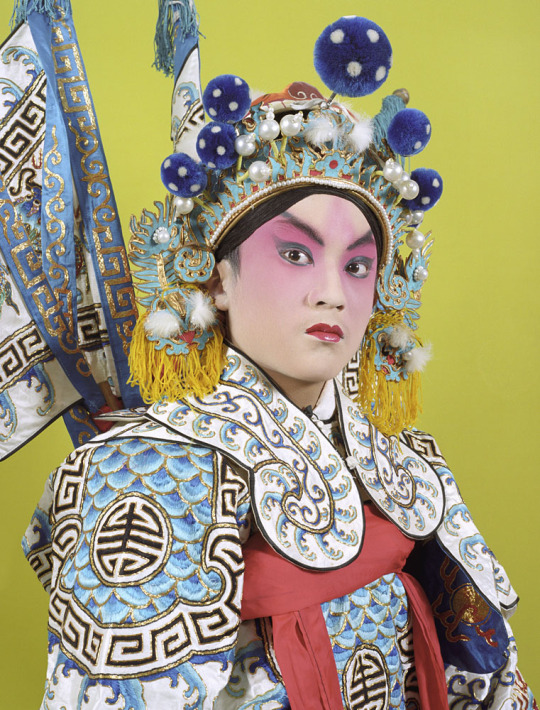
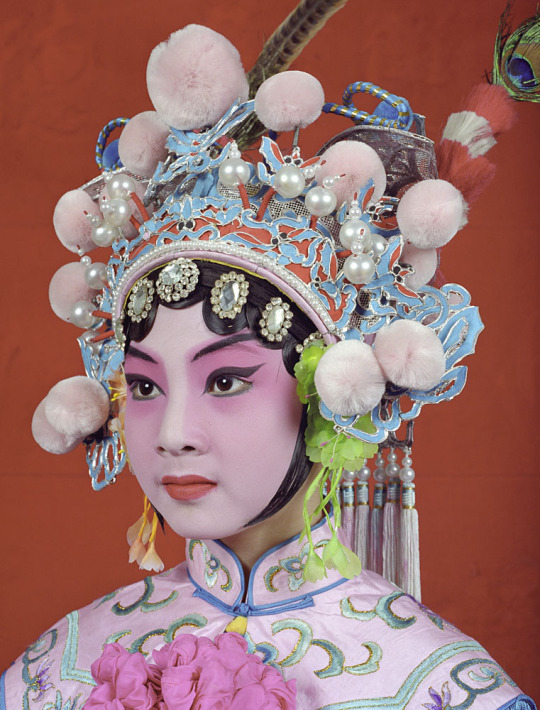
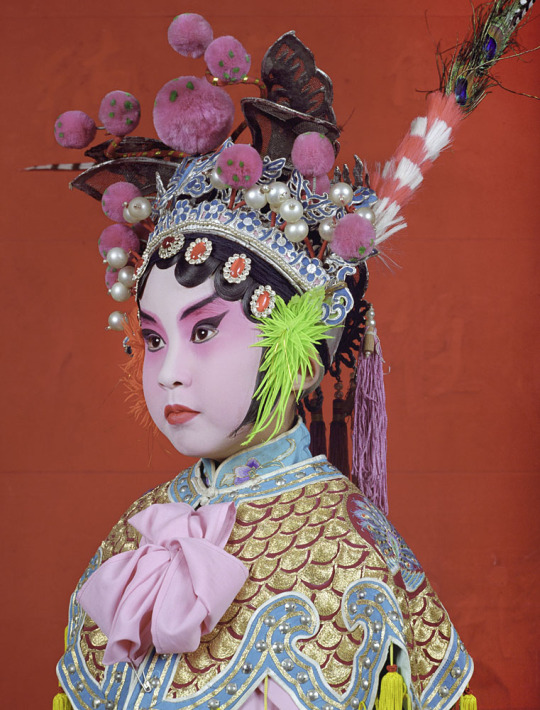
Rongqiu isn't used just for Chinese opera performances - it's a very common decorative item for Chinese headwear, especially for traditional/folk performances.
Below - examples of rongqiu use in folk custom/performance costumes, left to right: 1) 游神/youshen (wandering gods) procession in Fujian (x), 2) 英歌舞/yingge wu (yingge dance) performer in Guangdong (x), 3) & 4) 高跷/gaoqiao (stilt walking) performers in a 社火/shehuo parade in Gansu (x):

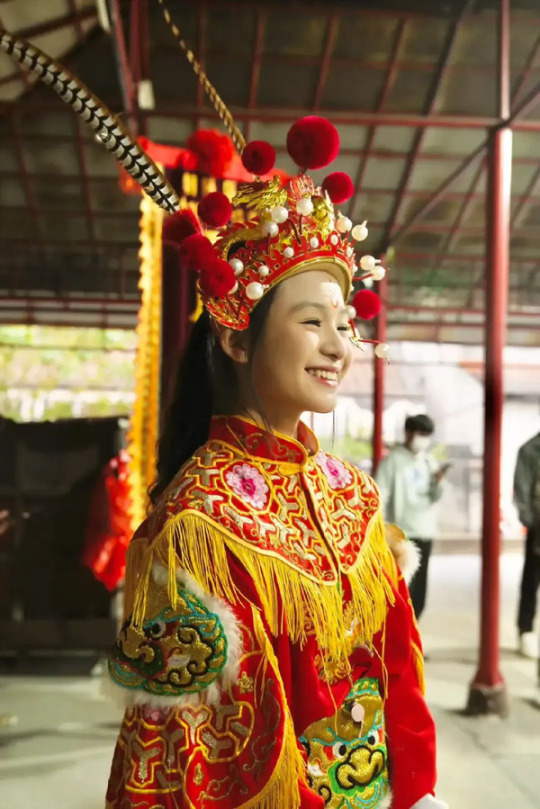

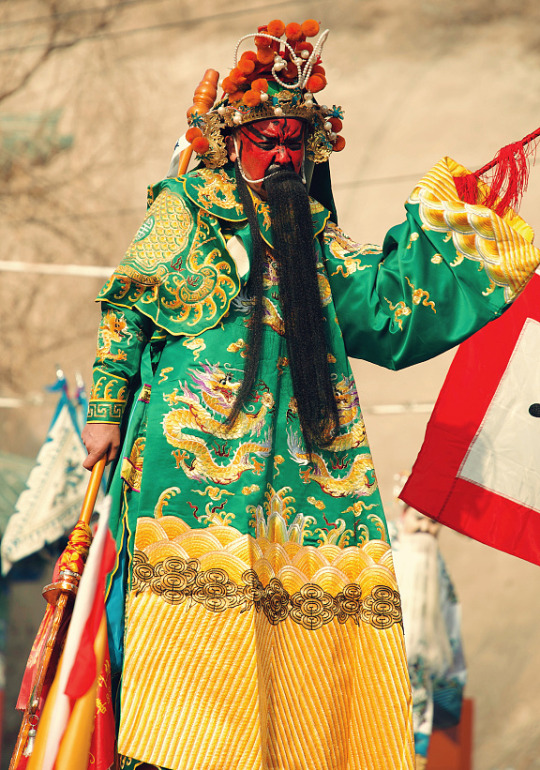
As a festive decoration, rongqiu was also widely used on bridal guan (crowns) from the Qing dynasty into the modern day.
Below - examples of rongqiu use in historical bridal guan: Left - a bride during the late Qing dynasty, circa 1890 (x); Right - a bride during the Republican era/minguo, in 1939 (x):
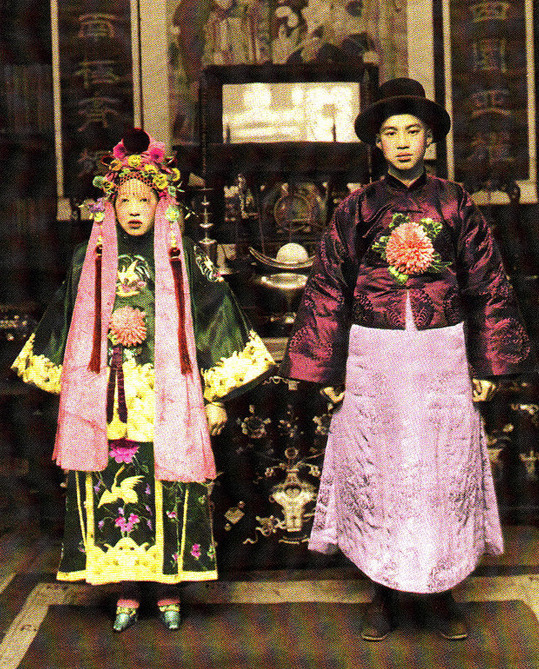
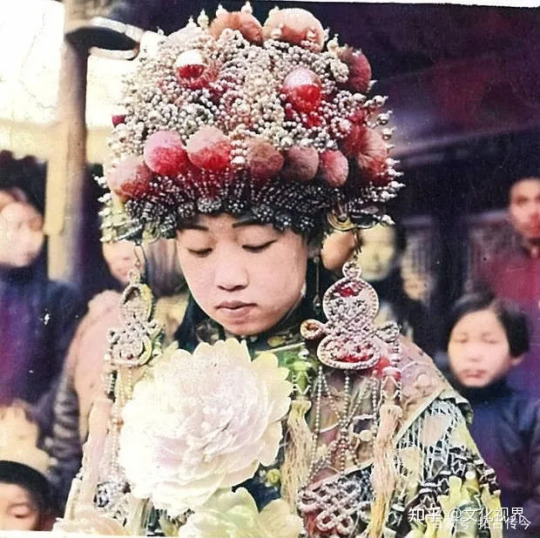
For some reason it's been extremely difficult to find sources on the origin of rongqiu that would shed more light on its significance, but based on historical paintings the use of rongqiu as a head ornament may have originated in the Qing dynasty. During the late Qing dynasty, it was fashionable among women to wear rongqiu on the sides of their hair, as can be seen in the paintings below (x):

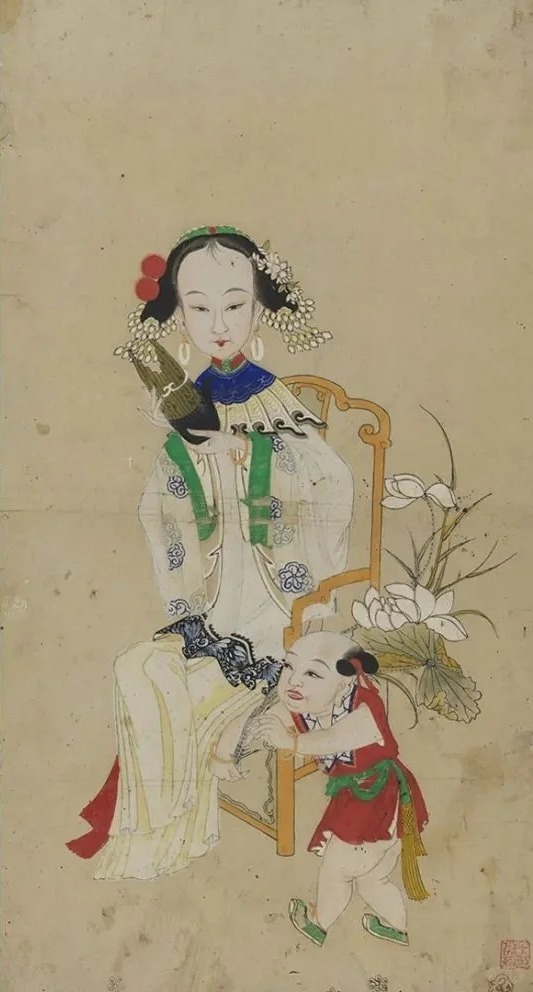
This particular style of rongqiu hair ornament was depicted in the 2012 historical cdrama 娘心计/Mother's Scheme:
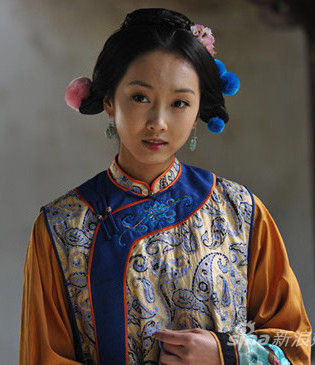
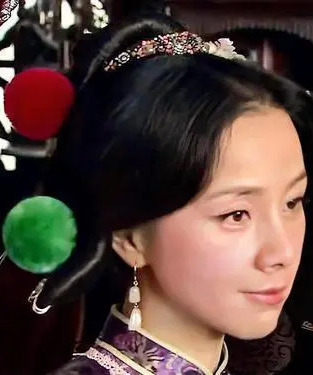
For more references, please see my rongqiu and kuitou tags.
If anyone has more information on the significance of rongqiu, please do share!
Hope this helps ^^
#rongqiu#pompoms#kuitou#chinese opera#opera costume#xifu#hanfu#history#reference#ask#reply#junpeicindystories#chinese fashion#chinese clothing#china
595 notes
·
View notes
Text
Administrative geography of Western Han (34,115)
According to Ban Gu's Book of Han.

Places names on the map:
You 幽州
Bohai勃海郡
Yangxin陽信
Dongguang東光
Fucheng阜城
Qiantong千童
Zhonghe重合
Ding定
Gaole高樂
Linle臨樂
Zhongping重平
Tiaoshi脩市
Zhangxiang章鄉
Puling蒲領
Ji冀州
Guangping廣平國
Quzhou曲周
Nanqu南曲
Xindu信都國
Xindu信都
Li歷
Fuliu扶柳
Biyang辟陽
Nangong南宮
Xiabo下博
Wuyi武邑
Guanjin觀津
Gaodi高隄
Guangchuan廣川
Lexiang樂鄉
Pingdi平隄
Tao桃
Xiliang西梁
Changcheng昌成
Dongchang東昌
Xiu脩
Hejian 河間國
Gonggao弓高
Wei魏郡
Guantao館陶
Qingyuan清淵
Wei魏
Yuancheng元城
Yin'an陰安
Ping'en平恩
Julu鉅鹿郡
Nanluan南䜌
Linping臨平
Shi貰
Qiao郻
Xinshi新巿
Tangyang堂陽
Lixiang歷鄉
Lexin樂信
Qinghe清河郡
Qingyang清陽
Dongwucheng東武城
Yimu繹幕
Ling靈
Cuo厝
Shu鄃
Beiqiu貝丘
Xincheng信成
Souti𢘿題
Dongyang東陽
Xinxiang信鄉
Liao繚
Zaoqiang棗彊
Fuyang復陽
Yan 兗州
Dong東郡
Liaocheng聊城
Dunqiu頓丘
Fagan發干
Fan范
Chiping茬平
Dongwuyang東武陽
Boping博平
Li黎
Qing清
Dong'e東阿
Lihu離狐
Linyi臨邑
Xuchang須昌
Shouliang壽良
Lechang樂昌
Yangping陽平
Linqiu廩丘
Chenliu陳留郡
Cheng'an成安
Ningling寧陵
Xiangyi襄邑
Yan傿
Shanyang山陽郡
Changyi昌邑
Nanpingyang南平陽
Chengwu成武
Huling湖陵
Dongmin東緍
Fangyu方與
Tuo橐
Juye鉅野
Shanfu單父
Bo薄
Duguan都關
Chengdu城都
Huang黃
Yuanqi爰戚
Gaocheng郜成
Pingle平樂
Xiaqiu瑕丘
Xiyang西陽
Jiyin濟陰郡
Dingtao定陶
Yuanqu冤句
Lüdu呂都
Jiami葭密
Chengyang成陽
Juancheng鄄城
Gouyang句陽
Du秺
Chengshi乘氏
Chengyang 城陽國
Ju莒
Yangdu陽都
Dong'an東安
Lü慮
Huaiyang淮陽國
Zhe柘
Dongping東平國
Wuyan無鹽
Rencheng任城
Dongpinglu東平陸
Fucheng富城
Zhang章
Kangfu亢父
Fan樊
Taishan泰山郡
Fenggao奉高
Bo博
Chi茬
Lu盧
Feicheng肥成
Yiqiu蛇丘
Gang剛
Chai柴
Gai蓋
Liangfu梁父
Dongpingyang東平陽
Nanwuyang南武陽
Laiwu萊蕪
Juping鉅平
Ying嬴
Mou牟
Mengyin蒙陰
Hua華
Ningyang寧陽
Shengqiu乘丘
Fuyang富陽
Taoshan桃山
Taoxiang桃鄉
Qing青州
Zichuan甾川國
Ju劇
Dong'anping東安平
Louxiang樓鄉
Jiaodong 膠東國
Jimo即墨
Xiami下密
Zhuangwu壯武
Yuzhi郁秩
Ting挺
Guanyang觀陽
Zoulu鄒盧
Gaomi高密國
Gaomi高密
Chang'an昌安
Shiquan石泉
Yi'an夷安
Chengxiang成鄉
Pingyuan平原郡
Pingyuan平原
Ge鬲
Gaotang高唐
Zhongqiu重丘
Pingchang平昌
Yu羽
Ban般
Leling樂陵
Zhu'e祝阿
Yuan瑗
Eyang阿陽
Tayin漯陰
Li朸
Fuping富平
Ande安悳
Louxu樓虛
Long'e龍頟
An安
Qiancheng千乘郡
Qiancheng千乘
Dongzou東鄒
Shiwo溼沃
Ping'an平安
Bochang博昌
Liaocheng蓼城
Jianxin建信
Di狄
Langhuai琅槐
Le'an樂安
Beiyang被陽
Gaochang高昌
Gaowan高宛
Yanxiang延鄉
Ji'nan濟南郡
Dongpingling東平陵
Zouping鄒平
Tai臺
Liangzou梁鄒
Tugu土鼓
Yuling於陵
Yangqiu陽丘
Panyang般陽
Jian菅
Zhaoyang朝陽
Licheng歷城
You猇
Zhu著
Yicheng宜成
Qi齊郡
Linzi臨淄
Changguo昌國
Li利
Xi'an西安
Juding鉅定
Guang廣
Guangrao廣饒
Linqu臨朐
Taixiang臺鄉
Beihai北海郡
Yingling營陵
Jukui劇魁
Anqiu安丘
Chunyu淳于
Yi益
Pingshou平壽
Ju劇
Duchang都昌
Pingwang平望
Liuquan柳泉
Shouguang壽光
Lewang樂望
Rao饒
Zhen斟
Sangdu桑犢
Pingcheng平城
Mixiang密鄉
Chengxiang成鄉
Jiaoyang膠陽
Donglai東萊郡
Ye掖
Chui腄
Pingdu平度
Huang黃
Linqu臨朐
Qucheng曲成
Mouping牟平
Dongmou東牟
Jian㡉
Yuli育犁
Changyang昌陽
Buye不夜
Dangli當利
Luxiang盧鄉
Yangle陽樂
Yangshi陽石
Xuxiang徐鄉
Yu豫州
Liang梁國
Dang碭
Zi甾
Shuqiu杼秋
Meng蒙
Yishi已氏
Yu虞
Xiayi下邑
Suiyang睢陽
Lu魯國
Lu魯
Bian卞
Wenyang汶陽
Pi蕃
Zou騶
Xue薛
Pei沛郡
Xiao蕭
Guangqi廣戚
Feng豐
Gongqiu公丘
Jingqiu敬丘
Pei沛
Jianping建平
Li栗
Fuyang扶陽
Qixiang祈鄉
Xu 徐州
Chu楚國
Pengcheng彭城
Liu留
Wu梧
Fuyang傅陽
Lü呂
Wuyuan武原
Langye琅邪郡
Dongwu東武
Buji不其
Haiqu海曲
Ganyu贛榆
Zhuxu朱虛
Zhu諸
Wucheng梧成
Lingmen靈門
Gumu姑幕
Linyuan臨原
Langye琅邪
Fei祓
Ju柜
Ping缾
Fu邞
Qianzou黔陬
Jijin計斤
Dao稻
Gaoyu皋虞
Pingchang平昌
Changguang長廣
Heng橫
Dongguan東莞
Weiqi魏其
Chang昌
Zixiang茲鄉
Ji箕
Bi椑
Gaoguang高廣
Gaoxiang高鄉
Li麗
Xinshan新山
Gaoyang高陽
Kunshan昆山
Zhequan折泉
Fangshan房山
Anqiu安丘
Donghai東海郡
Tan郯
Lanling蘭陵
Xiangfei襄賁
Xiapi下邳
Liangcheng良成
Pingqu平曲
Qi戚
Qu朐
Kaiyang開陽
Bi費
Licheng利成
Haiqu海曲
Zeng繒
Nancheng南成
Jiqiu即丘
Zhuqi祝其
Linyi臨沂
Houqiu厚丘
Rongqiu容丘
Dong'an東安
Hexiang合鄉
Zheng承
Jianyang建陽
Quyang曲陽
Siwu司吾
Duyang都陽
Yinping陰平
Wuxiang郚鄉
Xinyang新陽
Jianling建陵
Changlu昌慮
Not located
Dong東郡
Panguan畔觀
Limiao利苗
Shanyang山陽郡
Zhongxiang中鄉
Zheng鄭
Zixiang甾鄉
Lixiang栗鄉
Quxiang曲鄉
Jiaodong 膠東國
Changwu昌武
Pingyuan平原郡
Heyang合陽
Qiancheng千乘郡
Fan'an繁安
Taishan泰山郡
Shi式
Qi齊郡
Zhaonan昭南
Beixiang北鄉
Pingguang平廣
Beihai北海郡
Zhi瓡
Pingdi平的
Yangshi羊石
Ledu樂都
Shixiang石鄉
Shangxiang上鄉
Xincheng新成
Langye琅邪郡
Xushui虛水
Yujia雩假
Yun雲
Rou柔
Jilai即來
Wuxiang武鄉
Yixiang伊鄉
Canfeng參封
Boshi博石
Shenxiang慎鄉
Siwang駟望
Gaoling高陵
Lin'an臨安
Shishan石山
Donghai東海郡
Lanqi蘭祺
Shanxiang山鄉
Jianxiang建鄉
Yuxiang于鄉
Pingqu平曲
Wuyang武陽
Duping都平
County locations and ancient rivers, lakes, and shorelines from The Historical Atlas of China.
I have intentionally stuck to the Hanshu where it differs from the Historical Atlas.
8 notes
·
View notes
Text
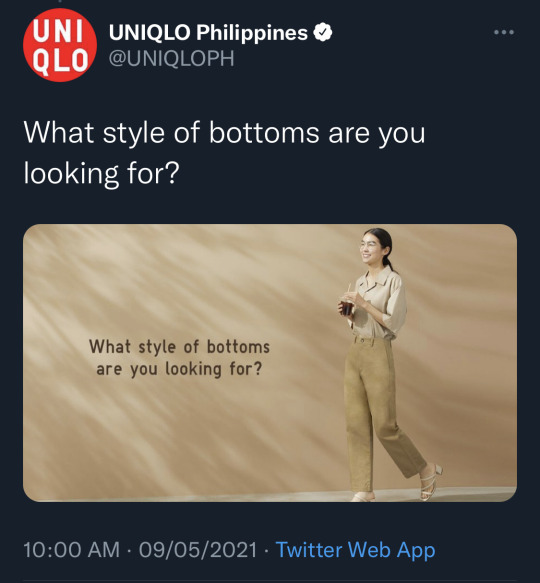
Answer: Educators

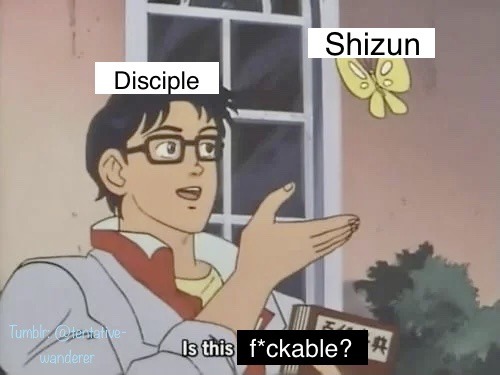
Thinking of: Chu Wanning (2ha), Shen Qingqiu, Shen Jiu (SVSSS), Shen Gurong (Transmigrated into a High-Risk Career: Shizun 穿成高危职业之师尊)
*
*
*
More debauchery here:
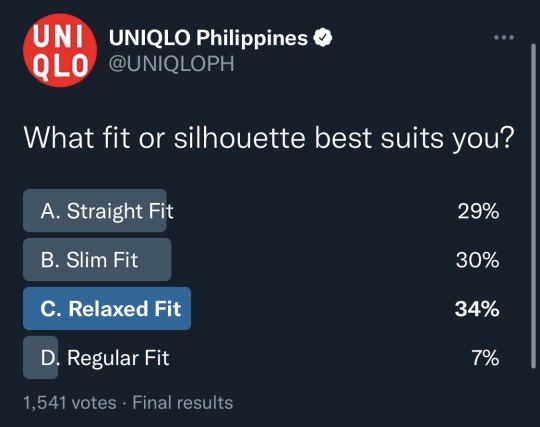
Answer: Misfits are interesting
Misfits (defined strictly): Chu Wanning (2ha), Mo Xuanyu (MDZS), Ye Rongqiu (好一朵美腻的白莲花 What A Lovely White Lotus) (this last one is a real weirdo. That’s a compliment.) Defined loosely: Wei Wuxian (MDZS), Chi Xiaochi (DPUBFTTB / DPUBFTB), Qu Yanting (Crossover Actor)
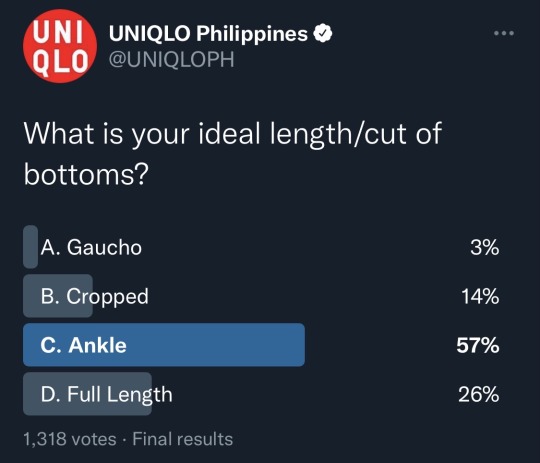
Answer: I don’t know, I think some people find “shorter than their tops (🍆)” cute?

Answer: Late risers (been ploughed by the tops too intensely at night)
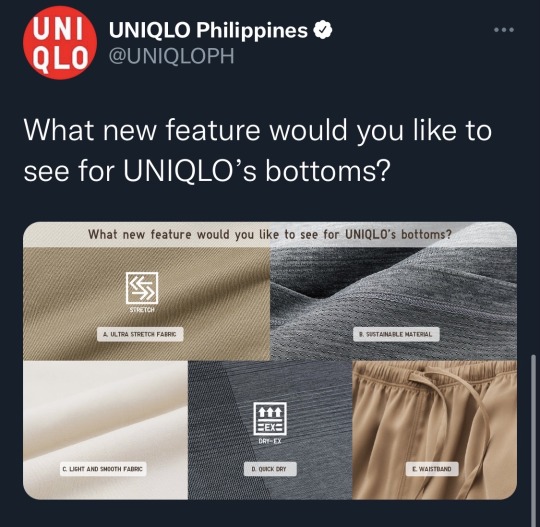
Answer: Erm…self-lubricating
#2ha#mdzs#svsss#dpubftb#cql#dpubfttb#danmei#crossover actor#好一朵美腻的白莲花#穿成高危职业之师尊#二哈和他的白猫师尊#魔道祖师#人渣反派自救系统#不要在垃圾桶里捡男朋友#跨界演员#my stuff
42 notes
·
View notes
Text
Chinese hanfu.

. 🅃🄷🄴 🄳🄰🅁🄺🄽🄴🅂🅂
102 notes
·
View notes
Note
The child’s hat is most likely a festival hat, very similar to the one here. As @fate-magical-girls mentioned in this post, “Depending on the holiday, children had a variety of festive hats. For example, during the Spring Lantern festival, there’s the carp hat. During the Full Moon festival, there’s the bunny hat. During the Hungry Ghost festival, there’s the lotus hat". If anyone knows specifically what type of hat this one is, please share ^^
Hi! So there’s this account on twitter that posts a lot of photos from the qing/republican era and there’s this one photo he tweeted of this adorable kid and his dad: /tongbingxue/status/1447830808849358850 what I’m curious about is what exactly the kid is wearing? Like do you know what that hat is called, the collar, the necklace, the shoes, etc.? No worries if you aren’t able to answer this question!
Hi, I assume it's this picture?

This is super adorable! I'm not sure about the hat (it looks kind of theatrical), but the collar is likely a 围涎 weixian, a sort of often embroidered circular collar for children. Judging by the etymology it was originally a napkin, though at the end of the 19th century it was very decorative. The necklace thingy is probably a 帽花 maohua, a decorative piece attached to children's hats and headpieces, not an actual necklace. The shoes seem to be regular winter shoes, just made for children. The Beijing Institute of Fashion Technology has artifacts for weixian and maohua.


Weixian and maohua, from the BIFT museum.
#weixian#maohua#festival hat#rongqiu#hats#qing dynasty#shoes#winter wear#shanghai#artifact#history#reference#ask#reply#audreydoeskaren#r
190 notes
·
View notes
Note
Just wanna say this influence also exists in lion dance!



Hi my friend wanted to ask about Chinese Opera and the red pom poms on their hats and their significance. I asked my mom and she said they were for decoration so I just wanted clarification
Hi! Thanks for the question, and sorry for taking ages to reply!
The pom poms you see on 盔头/kuitou (Chinese opera headdresses) are called 绒球/rongqiu (lit. "velvet ball"). They are often red, but can also be other colors, and vary in size. Ronqiu are decorative and serve to distinguish the many different types of kuitou from one another. Each type of kuitou is distinct in the number, size, and color of rongqiu that it's decorated with (of course, not all kuitou have rongqiu).
Below - a few different types of Beijing opera kuitou decorated with rongqiu (x):






Rongqiu isn't used just for Chinese opera performances - it's a very common decorative item for Chinese headwear, especially for traditional/folk performances.
Below - examples of rongqiu use in folk custom/performance costumes, left to right: 1) 游神/youshen (wandering gods) procession in Fujian (x), 2) 英歌舞/yingge wu (yingge dance) performer in Guangdong (x), 3) & 4) 高跷/gaoqiao (stilt walking) performers in a 社火/shehuo parade in Gansu (x):




As a festive decoration, rongqiu was also widely used on bridal guan (crowns) from the Qing dynasty into the modern day.
Below - examples of rongqiu use in historical bridal guan: Left - a bride during the late Qing dynasty, circa 1890 (x); Right - a bride during the Republican era/minguo, in 1939 (x):


For some reason it's been extremely difficult to find sources on the origin of rongqiu that would shed more light on its significance, but based on historical paintings the use of rongqiu as a head ornament may have originated in the Qing dynasty. During the late Qing dynasty, it was fashionable among women to wear rongqiu on the sides of their hair, as can be seen in the paintings below (x):


This particular style of rongqiu hair ornament was depicted in the 2012 historical cdrama 娘心计/Mother's Scheme:


For more references, please see my rongqiu and kuitou tags.
If anyone has more information on the significance of rongqiu, please do share!
Hope this helps ^^
595 notes
·
View notes
Note
I've mentioned rongqiu on here before, but @ziseviolet's post is way more in-depth regarding the topic. In ATLA, rongqiu appear to be popular among rich Earth Kingdom girls.


This makes sense, as rongqiu are traditionally made of mulberry silk, the most expensive of silks.
Hi my friend wanted to ask about Chinese Opera and the red pom poms on their hats and their significance. I asked my mom and she said they were for decoration so I just wanted clarification
Hi! Thanks for the question, and sorry for taking ages to reply!
The pom poms you see on 盔头/kuitou (Chinese opera headdresses) are called 绒球/rongqiu (lit. "velvet ball"). They are often red, but can also be other colors, and vary in size. Ronqiu are decorative and serve to distinguish the many different types of kuitou from one another. Each type of kuitou is distinct in the number, size, and color of rongqiu that it's decorated with (of course, not all kuitou have rongqiu).
Below - a few different types of Beijing opera kuitou decorated with rongqiu (x):






Rongqiu isn't used just for Chinese opera performances - it's a very common decorative item for Chinese headwear, especially for traditional/folk performances.
Below - examples of rongqiu use in folk custom/performance costumes, left to right: 1) 游神/youshen (wandering gods) procession in Fujian (x), 2) 英歌舞/yingge wu (yingge dance) performer in Guangdong (x), 3) & 4) 高跷/gaoqiao (stilt walking) performers in a 社火/shehuo parade in Gansu (x):




As a festive decoration, rongqiu was also widely used on bridal guan (crowns) from the Qing dynasty into the modern day.
Below - examples of rongqiu use in historical bridal guan: Left - a bride during the late Qing dynasty, circa 1890 (x); Right - a bride during the Republican era/minguo, in 1939 (x):


For some reason it's been extremely difficult to find sources on the origin of rongqiu that would shed more light on its significance, but based on historical paintings the use of rongqiu as a head ornament may have originated in the Qing dynasty. During the late Qing dynasty, it was fashionable among women to wear rongqiu on the sides of their hair, as can be seen in the paintings below (x):


This particular style of rongqiu hair ornament was depicted in the 2012 historical cdrama 娘心计/Mother's Scheme:


For more references, please see my rongqiu and kuitou tags.
If anyone has more information on the significance of rongqiu, please do share!
Hope this helps ^^
595 notes
·
View notes